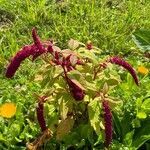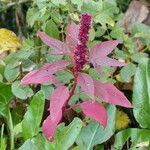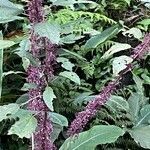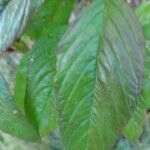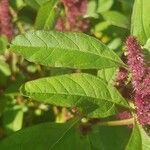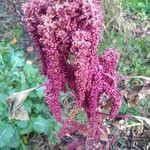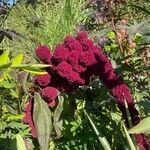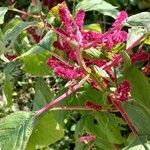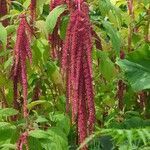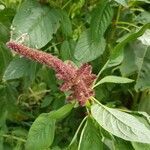Plants moderately pubescent distally, becoming glabrescent at maturity. Stems erect, usually green, moderately branched, rarely nearly simple, 0.5-1.5(-2.5) m. Leaves: petiole shorter than to equaling blade; blade rhombic-ovate, ovate, or elliptic to broadly lanceolate, 5-15(-20) × 2-10 cm, base cuneate, margins entire, apex acute to subobtuse, with mucro. Inflorescences terminal, drooping or nodding, usually red, purple, or white, less commonly green, silvery green, or yellow, usually much-branched at base, leafless at least distally, very large and robust. Bracts narrowly lanceolate to linear, equaling or subequal to tepals, not exceeding style branches, apex acuminate with excurrent midrib. Pistillate flowers: tepals 5, spatulate-obovate or lanceolate-obovate, not clawed, subequal, (1-)1.5-2(-2.5) mm, membranaceous, apex obtuse, slightly emarginate, or subacute with mucro; style branches spreading or reflexed; stigmas 3. Staminate flowers mostly at tips of inflorescences; tepals (4-)5; stamens 5. Utricles broadly ovoid to subglobose, 1.5-2(-2.5) mm, ± equaling tepals, dehiscence regularly circumscissile. Seeds dark brown to brownish black or reddish brown, yellowish white, or ivory, lenticular to subglobose, 1-1.2(-1.5) mm diam., smooth or indistinctly punctate.
Annual, erect, not or sparingly branched, 0.3-1½ m, unarmed; stem obtusangular, usually suffused with purple, thinly beset with patent short hairs. Leaves (larger ones at least) long petioled, rhomboid-ovate-lanceolate from cuneate base, in their upper half gradually narrowed, obtuse, mucronate, green, often bordered with purple; dimensions ?; nerves beneath usually pale. Flower-clusters very densely spicate; lower panicled; panicle in Malaysian specimens borne by a flaccid peduncle, drooping from the very base; terminal spike frequently much longer than the others; bracts and bracteoles broad, with a long apical point; many slightly exceeding the flowers. Perianth 5-merous. Tepals in ♂ ovate-oblong, shortly mucronate, in ♀ oblong-obovate-subspathulate, with at least partly overlapping margins, 2-2½ mm (including the often rather long mucro) by ⅔-¾ mm, purple. Styles 3, ± ¾ mm long. Utricle slightly exceeding perianth, lageniform, circumsciss. Seed 1-1¼ mm diam; dark brown, shining.
Cult. ornamental and grain-amaranth, apparently derived from the S. Amer. A. quitensis Kunth; monoecious, stout, erect, to 2 m; lvs long-petioled, elliptic to rhombic-ovate, to 2 dm; infl large and showy, generally bright red in life, composed of several to many drooping, spike-like thyrses, the terminal one 1–3 dm, much longer than the lateral; bract of the pistillate fls with slender midrib, not surpassing the fr; sep 5, outcurved above, the inner spatulate and obtuse or emarginate, all over 2 mm and nearly equaling the fr; style-branches slender, spreading from the base; seed most commonly pale ivory, and when fresh flushed with red around the rim, less commonly dark brown; 2n=32, 34. Amer. cultigen, originally cult. for grain, now relictual as a grain-plant, but widely cult. as an ornamental, occasionally escaping or persistent, but scarcely established in our range.
Annual herb; stem erect, to c. 1 m high, simple, rather angular, red-tinged, somewhat hairy. Petioles to c. 6 cm long, red-tinged. Lamina 3.5-11 × 1.5-5 cm (to 20 × 10 cm in cultivation), lanceolate-ovate or rhombic-ovate, glabrous above, ± puberulent on main veins beneath; base usually narrow-cuneate; apex obtuse and often mucronate. Infl. a dense spike-like panicle, usually interrupted near base, to c. 18 cm high, crimson, often with shorter lateral branches near base, the whole panicle pendulous from base. Rhachis hairy. Longer bracteoles 3-3.5 mm long, ovate with subulate tip; shorter bracteoles similar. Tepals 5, (1.2)-1.5-2.2 mm long, strongly imbricate, ± obovate, keeled; apex usually mucronate. Stigmas 3, crimson, > perianth. Frs slightly > perianth, circumscissile near the centre, ± urceolate. Seed 1-1.5 mm diam., orbicular, dark brown or black, shining.
Stem erect, green, ca. 1.5 m tall, strong, angular, slightly branched or not, glabrous when mature. Petiole green, 1-15 cm, pilose; leaf blade green or red, rhombic-ovate or rhombic-lanceolate, 4-15 × 2-8 cm, both surfaces glabrous, base cuneate, margin entire or undulate, apex acuminate or obtuse. Complex thyrsoid structures terminal, pendulous, much branched, composed of many spikes. Bracts red, lanceolate, ca. 3 mm, transparent, with a midvein abaxially, apex apiculate. Tepals red, shorter than fruit, 2-2.5 mm, transparent, overlapping at margins, with a midvein; male segments oblong; female segments oblong-lanceolate. Stamens 5; stigmas 3, shorter than 1 mm. Utricles red above, subglobose, ca. 3 mm in diam., longer than perianth, circumscissile. Seeds light yellowish brown, subglobose. Fl. Jul-Aug, fr. Sep-Oct. 2n = 32*, 64.
An annual plant which can be 2 m high and 45 cm across. The stems are angular and it can have a single stem or be branched. It is often limp in the upper parts. Plants are hairy at first but become smooth. Often they are tinged purple. Leaves are 2-4 cm long by 0.7-1.6 cm wide on a leaf stalk 0.5-1.5 cm long. Leaves can taper to a tip at the end. They can also thin towards the base. The veins are pale underneath. The flower clusters are in spikes on the side or top branches. The flowers are sometimes branched and can droop over. They can be 45 cm long. The fruit is oval. Seed are 1-1.3 mm across.
